You’ll need ten essential tools for professional chainmaking: draw plates for consistent wire sizing, chain nose pliers for precise link manipulation, a jeweller’s saw frame for accurate cutting, a reliable soldering torch with fire-safe work surface, ring mandrel for uniform jump rings, files and abrasives for smooth finishing, an annealing pan for heat treatment, specialized tweezers for handling hot components, and a bench vise for secure workholding. These tools guarantee your chains match commercial quality standards and prevent costly material waste through proper technique.
Draw Plates for Wire Consistency and Sizing
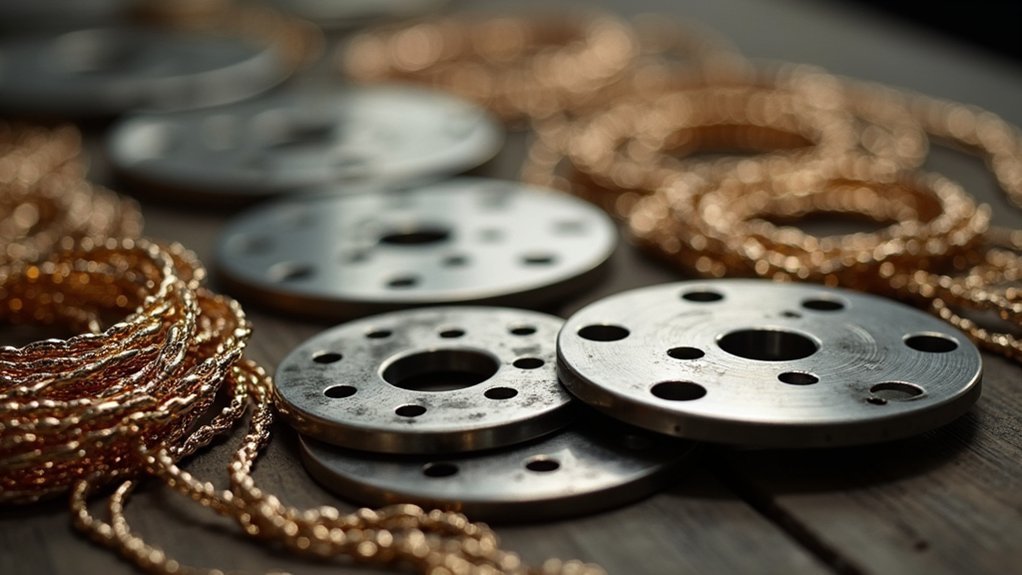
When creating professional-quality chains, you’ll find that draw plates serve as indispensable tools for achieving the wire consistency that separates amateur work from masterful craftsmanship.
These essential jewelry-making tools feature progressively smaller holes that let you reduce wire diameter gradually while maintaining precise control throughout the chainmaking process.
You’ll appreciate how draw plates work with various metal types, including silver, gold, and copper, making them versatile additions to your workshop.
The gradual sizing process guarantees each chain link maintains consistent diameter and shape, directly impacting both structural integrity and visual appeal.
Consistent wire diameter through gradual sizing ensures superior chain durability and professional aesthetic quality in every handcrafted piece.
Remember to lubricate your wire and apply even pressure when drawing to prevent damage and achieve excellent results in your chainmaking projects.
Chain Nose Pliers for Link Manipulation and Assembly
Chain nose pliers become your primary tool for the intricate work of manipulating and assembling individual links once you’ve drawn your wire to perfect specifications. Their tapered jaws provide precise gripping capabilities, allowing you to bend wire with accuracy while the flat inner surfaces prevent slipping on delicate components. You’ll find these pliers indispensable for opening and closing jump rings, ensuring seamless connections between chain links.
| Feature | Benefit | Emotional Impact |
|---|---|---|
| Ergonomic handles | Reduced hand fatigue | Confidence in long projects |
| 5-6 inch length | Ideal leverage | Control over your craft |
| Flat inner surfaces | No component damage | Pride in flawless work |
The comfortable grip and enhanced control transform tedious assembly work into precise artistry, making every connection perfect.
Jeweller’s Saw Frame for Precise Metal Cutting
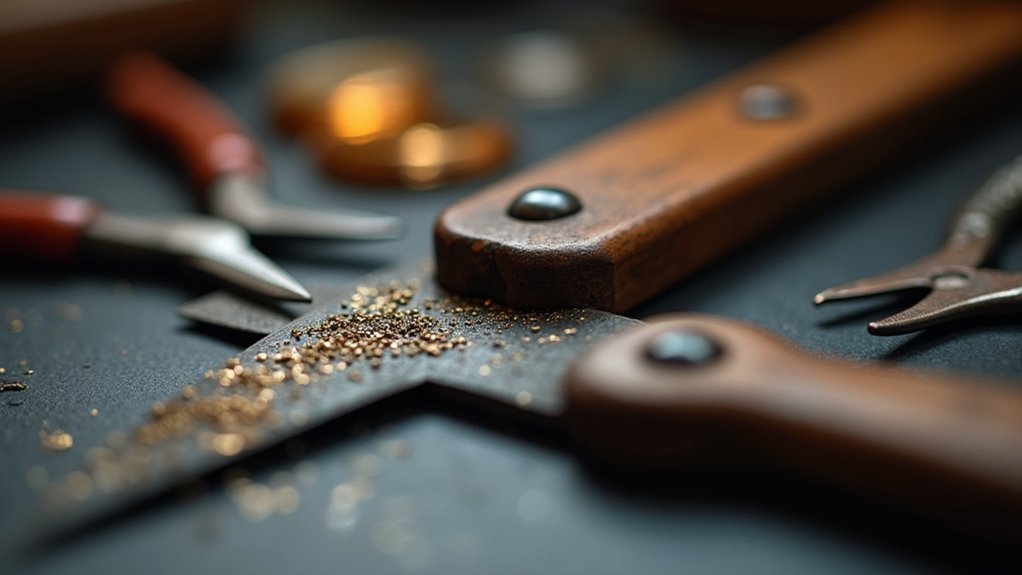
Precision cutting transforms raw metal sheets into the individual components that’ll form your chain’s foundation, and the jeweller’s saw frame serves as your primary instrument for this critical task.
This essential tool accommodates various saw blades ranging from 0.3mm to 1.3mm thickness, giving you flexibility to cut different metal types with exceptional cutting accuracy.
Your jeweller’s saw should be lightweight yet sturdy to minimize fatigue during extended use while maintaining stability for precise metal cutting.
Consider these key factors:
- Blade compatibility – Choose frames that accept standard blade sizes for versatility
- Frame tension – Proper blade tension guarantees clean, accurate cuts
- Ergonomic grip – Comfortable handles reduce hand strain during detailed work
- Lubrication maintenance – Regular blade lubrication reduces friction and extends blade life
Well-maintained equipment delivers cleaner edges on each chain link.
Soldering Torch and Fire-Safe Work Surface
After cutting your chain components, you’ll need a reliable soldering torch to create permanent joints between metal links. The Smith acetylene air outfit works excellently for chainmaking, with a #00 torch tip handling general tasks and a #1 tip for larger components.
You’ll require a fire-safe work surface like a honeycomb soldering board that reflects heat and protects your workspace from damage.
Essential safety equipment includes copper tongs for handling hot metals without burns. Don’t overlook critical safety precautions – wear safety goggles and a fume respirator to protect against soldering fumes and flying debris.
These protective measures guarantee you can work confidently while maintaining the high temperatures necessary for creating strong, permanent connections in your precious metal chains.
Ring Mandrel for Shaping Consistent Jump Rings
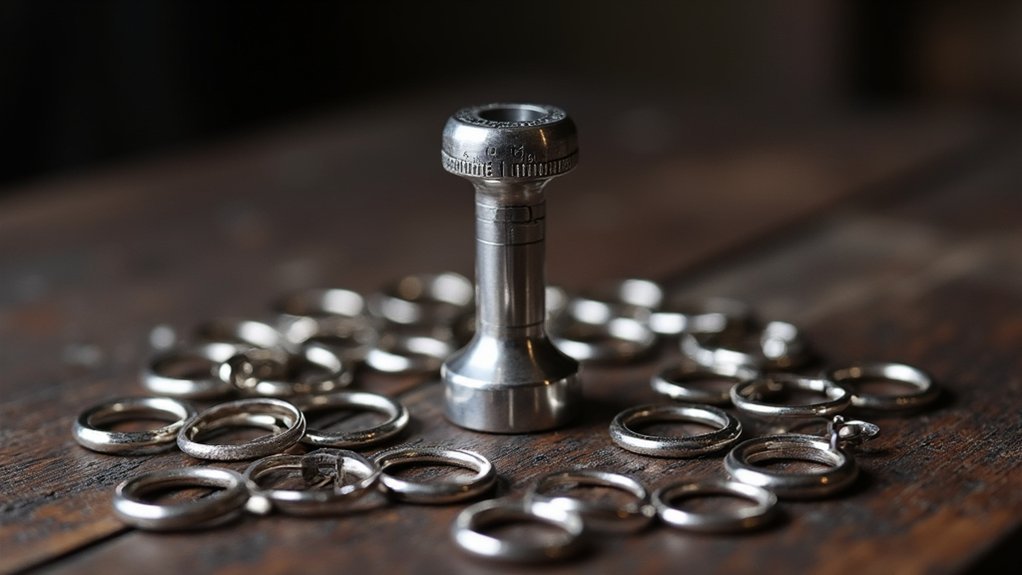
One essential tool that transforms amateur-looking chains into professional-grade jewelry is the ring mandrel. This tapered tool creates perfectly uniform jump rings, eliminating the inconsistent shapes that plague handmade chains.
You’ll find ring mandrels made from metal or plastic, featuring graduated markings for precise size control.
Here’s how to maximize your ring mandrel’s effectiveness:
- Choose your size – Select the appropriate marking on the mandrel for your project needs.
- Wrap consistently – Wind your wire around the mandrel at your chosen size marking.
- Slide and cut – Remove the formed ring and cut to desired length.
- Repeat precisely – Use the same marking for every jump ring to guarantee uniformity.
Standard mandrels accommodate sizes 1-15, making them versatile essential tools for various chainmaking applications while enhancing your work’s professional quality.
Wire Gauges and Measuring Tools for Accuracy
You’ll need to master wire gauge numbers since they work counterintuitively—higher numbers mean thinner wire, so 24-gauge is stronger than 30-gauge for your chainmaking projects.
Essential measuring tools like metal rulers, digital calipers, and wire gauge tools guarantee you’re working with precise measurements every time.
These precision instruments help you create consistent chain links and avoid costly material waste when planning your designs.
Understanding Wire Gauge Numbers
Since wire gauge numbers determine the thickness of your wire, mastering this system becomes essential for successful chainmaking.
You’ll need to understand that higher numbers mean thinner wire—20-gauge wire is actually thicker than 28-gauge wire, which often confuses beginners.
The American Wire Gauge (AWG) system guides your jewelry making decisions:
- 24-gauge wire works perfectly for larger beads and substantial chain links
- 30-gauge wire suits delicate applications and intricate designs
- Wire gauge tools help you identify thickness and maintain consistency
- Metal rulers and caliper gauges guarantee accurate measurements throughout your project
Understanding these numbers helps you select appropriate wire for specific designs, affecting your chain’s strength, flexibility, and appearance.
Proper measuring tools become indispensable for achieving professional results in chainmaking.
Essential Measuring Tool Types
Accurate measurements form the backbone of professional chainmaking, and selecting the right measuring tools can make or break your project’s success.
You’ll need several precision measuring tools to achieve consistent results. A wire gauge tool helps you quickly identify different wire thicknesses, guaranteeing you’re using the correct material for each project. Digital calipers provide exact measurements down to the millimeter, creating uniform links that enhance your chain’s overall appearance.
A metal ruler or caliper gauge guarantees components fit together perfectly during assembly. These tools prevent costly mistakes and maintain the high standards expected in precious metal work.
Without accurate measurement capabilities, even slight discrepancies will compromise your chain’s functionality and visual appeal.
Precision for Chain Links
Everything about professional chainmaking hinges on selecting the proper wire gauge for your specific project requirements.
You’ll need accurate measurements and the right tools that every jewelry maker considers essential for creating consistent, durable chains.
For successful chain-making, focus on these critical elements:
- Wire Gauges 18-22: These provide the perfect balance between strength and flexibility for most chain projects.
- 20-Gauge Wire: Ideal for medium-sized links that offer both durability and workability.
- Calipers and Metal Rulers: Essential measuring tools that guarantee consistent link dimensions throughout your project.
- Regular Calibration: Check your measuring tools frequently to maintain precision for seamless link connections.
Using a disk punch helps cut uniform circles from metal sheets, assuring each link maintains consistent sizing for that polished, professional appearance you’re after.
Files and Finishing Abrasives for Link Refinement
Precision marks the difference between amateur and professional chainmaking, and your choice of files and finishing abrasives directly impacts the final quality of each link.
You’ll need needle files for small components and larger files for substantial chain links. Various shapes—flat, half-round, and round—let you tackle intricate designs and guarantee even surface finishing.
Your sanding sheets should range from 120 to 3000 grit for progressive smoothing and polishing. Start coarse and work toward finer grits to achieve ideal shine.
After filing and sanding, apply polishing compounds with buffing wheels for professional-grade results that elevate your chain’s aesthetic quality.
Maintain your finishing abrasives by cleaning and storing them properly. This extends their lifespan and assures consistent refinement quality across all your chainmaking projects.
Annealing Pan for Metal Heat Treatment
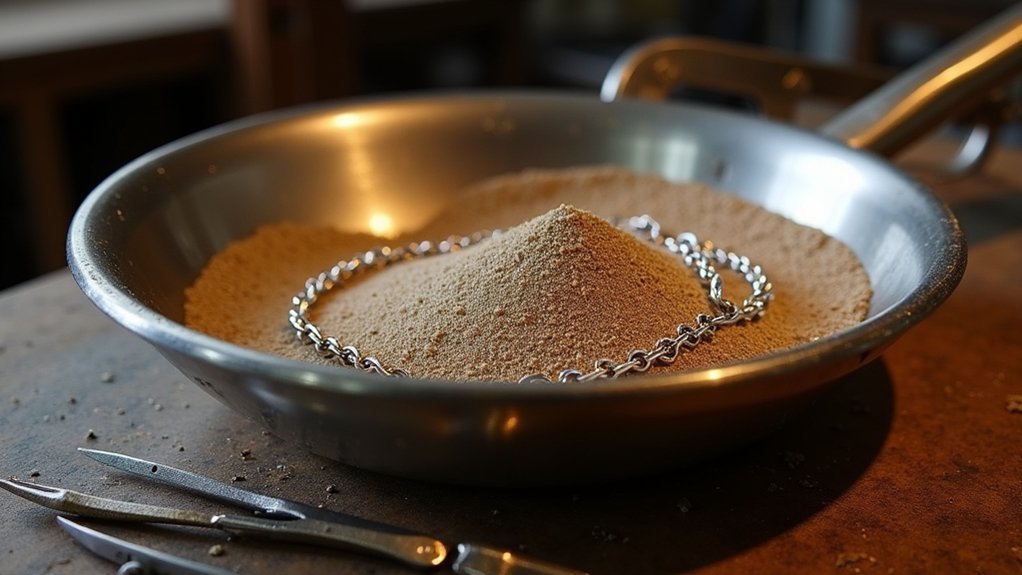
When you’re working with precious metals in chainmaking, an annealing pan becomes essential for safely heating your materials during the stress-relief process that improves ductility in gold and silver.
These specialized pans are crafted from heat-resistant ceramic or metal materials that won’t warp under extreme temperatures.
For effective heat treatment, follow these key steps:
- Fill with heat-safe medium – Use vermiculite or sand to distribute heat evenly
- Monitor temperature range – Heat precious metals between 300°C to 600°C depending on alloy composition
- Prevent oxidation – The medium protects your metal from harmful oxygen exposure
- Cool gradually – Let materials cool slowly in the annealing pan to maintain improved properties
This controlled heating process guarantees your chain links remain workable without cracking or warping during fabrication.
Tweezers for Handling Hot Metal Components
After heating your metal components in the annealing pan, you’ll need specialized tweezers to safely handle those scorching hot pieces without risking burns or dropping valuable materials. These essential tools feature wooden or insulated handles that protect your hands while providing superior grip control.
For jewelry making success, choose tweezers with tapered tips that enhance precision during intricate chain assembly tasks. The design allows you to manipulate small parts and access tight spaces between chain links effortlessly.
| Feature | Benefit |
|---|---|
| Stainless Steel Construction | Heat resistance and durability |
| Insulated Handles | Burn protection and comfort |
| Tapered Tips | Enhanced dexterity for detail work |
Invest in jewelry-specific tweezers that offer the strength and precision required for handling delicate hot metal components throughout your chainmaking process.
Bench Vise for Secure Work Holding
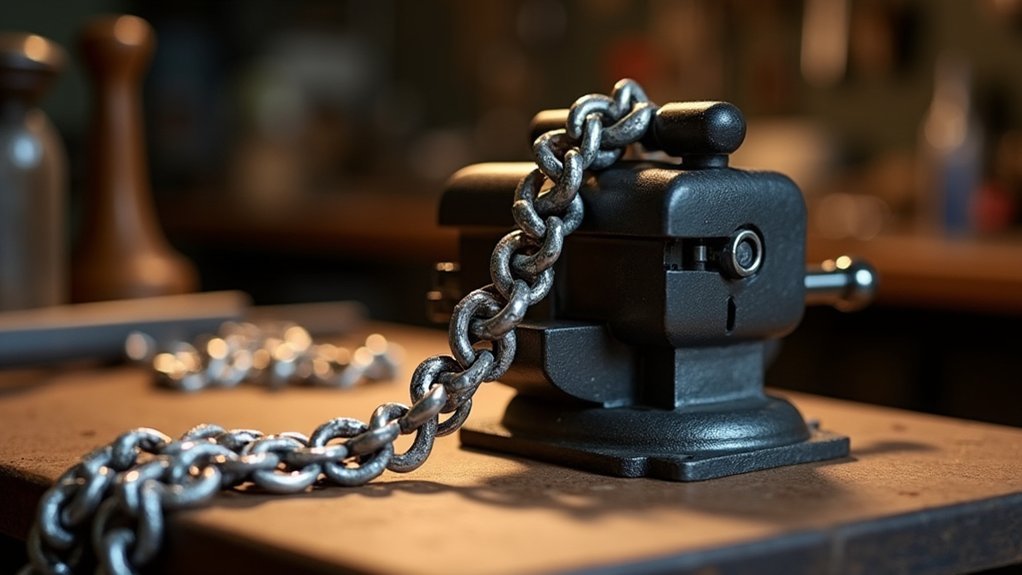
Stability forms the foundation of professional chainmaking, and a quality bench vise delivers the unwavering hold you need for precise metalwork.
This essential tool transforms your workspace into a secure work holding station, enabling accurate cutting, bending, and soldering operations.
When selecting a high-quality bench vise for chainmaking, consider these key features:
- Rubberized jaws that protect delicate metal surfaces from scratches and marring while maintaining firm grip
- Adjustable jaws that accommodate various chain link thicknesses and shapes for maximum versatility
- Solid mounting system that prevents slippage and enhances safety during intricate work
- Durable construction that withstands repeated use and maintains accuracy over time
A well-chosen bench vise greatly improves your chainmaking efficiency and reduces costly errors.
Frequently Asked Questions
What Tools Do I Need for Metal Jewelry Making?
You’ll need chain nose pliers, flat nose pliers, round nose pliers, a jeweller’s saw, wire cutters, measuring tools, soldering equipment with gas torch, and polishing papers to create professional metal jewelry pieces.
What Equipment Do You Need to Be a Jeweler?
You’ll need a sturdy workbench, quality pliers, jeweler’s saw with blades, measuring tools like calipers, safety equipment including goggles, and various files, hammers, and torches for professional jewelry making work.
What Tools Do You Need to Make a Gold Ring?
You’ll need a jeweller’s saw for cutting gold, a ring mandrel for shaping, a gas torch for soldering, flat nose pliers for manipulation, and polishing papers for finishing your ring.
What Supplies Do I Need to Start Making Jewelry?
You’ll need basic pliers like flat nose and round nose for wire work, a jeweller’s saw for cutting, soldering equipment for joining metals, measuring tools, and polishing papers for finishing touches.
In Summary
You’ll find that mastering chainmaking requires the right tools working together as a system. Don’t skimp on quality—invest in professional-grade equipment that’ll last through countless projects. Start with the basics like draw plates and chain nose pliers, then expand your toolkit as your skills develop. Remember, consistent practice with these tools will transform your technique from amateur attempts into professional-quality chains that’ll showcase your metalworking expertise.

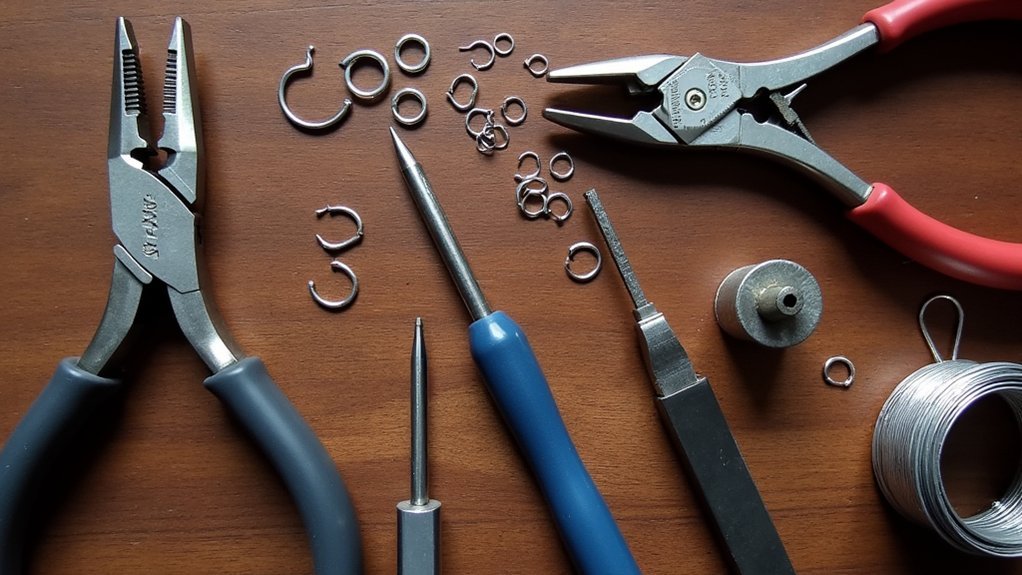



Leave a Reply